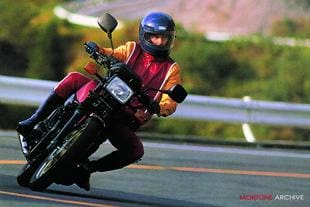
Some otherwise great motorcycles of the seventies and eighties were doomed to obscurity simply because they were unable to make a splash when they first appeared.
So it was with Kawasaki’s GT550. It was launched in 1983 as a more sober alternative to the intoxicatingly swift GPz550 sportster. It provided the then novel combination of a 550cc four with shaft drive and swiftly gained a reputation as a viable and practical alternative to BMW’s classy tourers.
But the GT550 looked as dull as dust. Next to the GPz550’s fiery red finish, the GT550 faded into the shadows with metallic brown paint and black detailing. Even though Kawasaki livened up its appearance in later years, it wasn’t enough. The GT550 was seen as the ugly duckling.
That’s been reflected in this magazine. Take a look through the archive of articles in Classic & Motorcycle Mechanics. You won’t find a mention. Fact is that the GT550 is one of Kawasaki’s lost models. Ring up their UK press office. You get a silence. “Er, GT550? What was that?” was the gist of the response. Quite.
Yet the GT550 was one of Kawasaki’s most usefully practical models, and was listed in its range for almost two decades: it was very smooth, reasonably nimble (for the time) and offered a good touring range, all of which made it as popular a mount in the dispatch rider business as Honda’s even less attractive-looking CX500, known endearingly as the Maggot.
And the GT550 was also possibly one of Kawasaki’s most reliable models. Many examples have lasted for 100,000 miles or more and members of the Kawasaki GT Club will swear by its mile-eating unstoppability. Its indestructibility also means that there are reports of GTs with just two ratios in the box and half of the cylinders firing being limped around cities by unflappable dispatchers who were immune to its shot air-sprung suspension.
The story started back in the late seventies when Kawasaki developed a more compact version of its successful Z650 four. The Z500 four (497cc, 55 x 52.4mm) was launched in 1979, followed a year later by the overbored Z550 (553cc, 58 x 52.4mm) and in 1982 the sporty GPz550.
These all used an air-cooled four-cylinder engine with chain-driven double overhead camshafts and two valves per cylinder. With the unit breathing through a quartet of Tekei CV 30mm carbs, power was fed through an inverted-tooth chain from the centre of the plain-bearing crankshaft and gears to a wet multiplate clutch and six-speed gearbox.
Completely redesigned
For the GT550, Kawasaki completely redesigned the engine’s cases to include a set of spiral bevel gears on the gearbox output shaft along with a spring-loaded transmission shock absorber. A universal coupling fitted inside the left-side swing arm along with the shaft that connected to another set of spiral bevels at the rear wheel. The shaft drive, which didn’t present the engine with the thrust forces created by a chain, also enabled the engine to be rubber mounted.
On the road, this offered a novel experience. The engine, detuned to peak at 55.2bhp at 9,500rpm with shorter valve timing and a lower compression ratio compared with the GPz550’s 58bhp, delivered instant throttle response through the four Tekei CV carburettors over a wider rev range and with more precision. And while the other 553cc fours could hardly be called buzzy, the GT’s acceleration through the gears was almost vibrationless.
The GT didn’t have the top end rush of the sports bike but it could hold slightly more than the ton as you gripped the taller clip-on handlebars and sank back into the supple seat.
 At those speeds the upright riding position, acceptable around town, turned the rider into a sail and the machine started to wander. But up to 90mph it was adequately precise and you could comfortably make the most of the big 4.7 gallon tank’s range, packing 200miles between top ups. The limitation was with the footrests, which were wider than on the other models because the use of the drive shaft necessitated a broader frame across the swing arm pivot.
At those speeds the upright riding position, acceptable around town, turned the rider into a sail and the machine started to wander. But up to 90mph it was adequately precise and you could comfortably make the most of the big 4.7 gallon tank’s range, packing 200miles between top ups. The limitation was with the footrests, which were wider than on the other models because the use of the drive shaft necessitated a broader frame across the swing arm pivot.
The use of air as the suspension medium for the leading-axle fork and the rear shocks also enabled a measure of tuning to accommodate a variety of rider weights. Few bikes offer as versatile a suspension set up as the GT550. Load variations could be adjusted for by using a small air pump on the valves. There was one each for the front and rear with connecting tubes. Rebound damping was also adjustable on the rear shocks. But the set up could never be as taut as springs and the lush ride slowed the steering.
I rode the GT550 while working for Which Bike? magazine and though I didn’t write the road test (which was entrusted to that champion of dispatch riders Colin Schiller) I did put the bike through its paces at MIRA’s proving ground.
Having just jumped from testing a CB900F Honda with its pistol-grip feel, the GT550 was like being planted on an armchair with trials handlebars. But I quickly adapted to the quaint position of the grips and wound the engine to the red line through the six gears. It was immediately obvious that the bike was geared for mid range response, rushing past peak power revs of 9,000rpm at 108mph and revving to almost 10,000 at 116mph flat out, some six mph less than the following year’s GPz.
Quarter mile
Standing quarter mile acceleration times were also slower with figures of 13.57s at 96.39mph, hardly surprising for a bike that weighed 476 pounds, but the GT550 seemed completely unconcerned at being thrashed.
It stopped with an equal lack of drama, but with surprising potency. The relatively small twin front discs were gripped by metallic pads in floating calipers, but offered a bite out of all proportion to their size. In time, the design would also display high wear rates.
 In summary, let Schiller outline his reactions. “It’s amazing what an old fart most of the world sees you as just ’cos you ride a bike with fork gaiters, sandwich rack and a 19-inch front wheel,” he said. “But the GT’s no slouch and building up the revs without too much caution produces cheeky little wheelies on the clutch (due to the directness of the shaft drive) and some creditable speed in the gears.
In summary, let Schiller outline his reactions. “It’s amazing what an old fart most of the world sees you as just ’cos you ride a bike with fork gaiters, sandwich rack and a 19-inch front wheel,” he said. “But the GT’s no slouch and building up the revs without too much caution produces cheeky little wheelies on the clutch (due to the directness of the shaft drive) and some creditable speed in the gears.
“Truth is the GT550 will in most hands hardly be tested to its surprisingly grand limits. Now I’m not trying to preach and infer that it’s a waste, it was just a surprise to discover that the GT handled so fab. Steering, though hardly in the same U-turn league as the new 16-inch jobs, is plenty quick enough, making easy work of big-city bumbling and restoring faith in your calculations when you get close to the precociously generous ‘tilt’ line – it’s totally predictable.”
Over the years, Kawasaki improved the GT550’s appearance with brighter paintwork and more chrome plate, and made a number of minor changes to the ignition system and carburettors.
In 1991, I rode what the factory called the Z550-G7, the model having incarnated through a number of versions. Most significant changes were the use of bright chrome for the exhaust system and jauntier graphics and paint for the 1984 Z550-G2, along with an electronically-controlled ignition advance. Others included a switch to 30mm Mikuni CV carbs on the Z550-G4 instead of the 26mm Tekeis and a return to a mechanical ignition advancer.
But in 1991 Kawasaki had started offering its ‘retro’ style range with the Z550 Zephyr, and the remodeled cylinder block and head were also adopted on the GT550 along with longer valve timing (a 270-degree opening period rather than 248 degrees) that lifted the power band to higher revs and resulting in claimed peak power of 59.1bhp at 10,000rpm.
Even then it seemed like some throwback from a previous era. Yet eight years after its UK launch, it was still selling well.
 The reason for the GT550’s enduring sales success was that it was perfectly adapted to its market. Despatch riders wanted a bike that easy to ride and simple to service. Compact proportions make the GT550 manageable in town, yet the smooth engine and fuss-free transmission provided for dependable and tireless long-distance travel.
The reason for the GT550’s enduring sales success was that it was perfectly adapted to its market. Despatch riders wanted a bike that easy to ride and simple to service. Compact proportions make the GT550 manageable in town, yet the smooth engine and fuss-free transmission provided for dependable and tireless long-distance travel.
Even the instruments showed the way Kawasaki was thinking nearly a decade earlier. The console incorporated a computer-controlled LCD that provided a check on battery condition, side-stand position and fuel level. In the face of the tacho there was a charging voltage meter operated when a button next to the trip reset was pressed. Big chunky switches were uncomplicated to use and included self-cancelling indicators.
The power increase had jumped ahead of the chassis because the top speed had been raised to about 120mph. The extra top end rush had been paid for with a small loss of bottom end and although the GT550 pulled well through the range, it didn’t pick up usefully until 3,000rpm appeared on the tacho. That meant more use of the six-speed gearbox.
Kawasaki continued to offer the GT550 for another decade without major changes, suggesting that there was nothing wrong with what was a basically solid package. By the turn of the 21st century it had been overtaken not so much by style and market changes but a need to meet ever more stringent emission laws coming from Europe. ![]()












